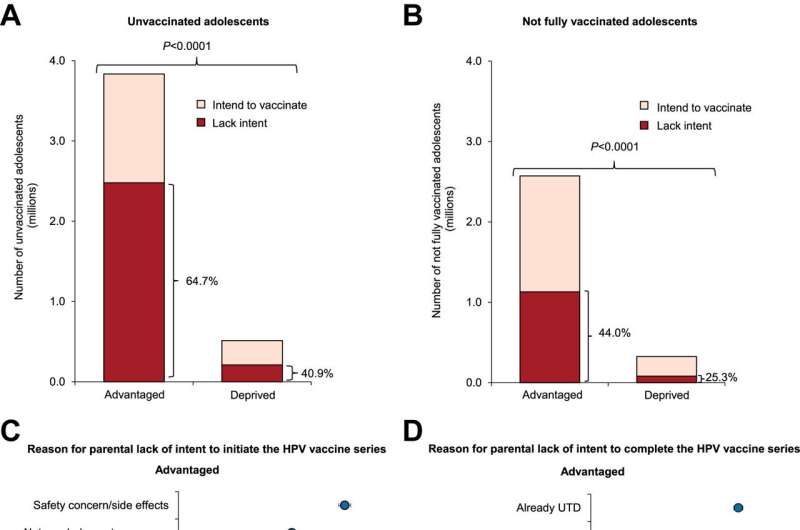This article has been reviewed according to Science X's editorial process and policies. Editors have highlighted the following attributes while ensuring the content's credibility:
fact-checked
trusted source
proofread
Socioeconomically advantaged individuals less likely to seek out HPV vaccination for their children, researchers find

The parents of millions of teens have no intention of getting their children vaccinated against the human papillomavirus (HPV). Parents with higher socioeconomic status are less likely than parents of lower income or educational attainment to plan to vaccinate their children.
HPV can cause six types of cancer in both males and females, which is why public health advocates want to see more people vaccinated. The U.S.'s Healthy People 2030 set a goal of 80% of adolescents receiving the full vaccine series, but that rate has stagnated at about 63% for teens.
Researchers from MUSC Hollings Cancer Center, aware of the so-called "reverse disparity," in which people from low-income or minority communities have better HPV vaccination coverage than people from more advantaged communities, wanted to understand the level of vaccine hesitancy and uncover the reasons that might lead to differences in vaccination coverage.
They used the survey results of the National Immunization Survey-Teen, an annual telephone survey that covers several routine adolescent vaccines. Their findings are published this week in The Lancet Regional Health—Americas.
The researchers found that a majority of socioeconomically advantaged parents—65%—did not intend to seek out the vaccine for their teens, compared with 40% of parents in the disadvantaged group.
The reasons differed by group. Advantaged parents generally cited safety concerns, while disadvantaged parents cited a lack of knowledge about the vaccine, lack of recommendation by a primary care provider, or the feeling that the vaccine isn't necessary.
"Parents from socioeconomically advantaged households could be undermining HPV infection risk for their child," said lead author Kalyani Sonawane, Ph.D., a Hollings researcher and an associate professor in the Department of Public Health Sciences. "The side effects of HPV vaccine are also possibly exaggerated in the minds of parents."
Senior author Ashish Deshmukh, Ph.D., co-leader of the Cancer Control Research Program at Hollings, noted that white parents, regardless of whether they were advantaged or disadvantaged, showed a "pervasive" lack of intent to vaccinate.
Given that just over half of all adolescents are white, their parents' vaccination decisions have a significant impact on the herd immunity of the entire age group.
"It has implications at the population level because if most adolescents are white and from middle- or high-income families, and if their parents perceive the vaccine not to be safe, then that impacts vaccine coverage," Sonawane said.
Previous studies have indicated that minority parents were more likely to accept the vaccine and perceive the threat of HPV infection to be greater. They are not necessarily wrong—Black and Hispanic women have higher rates of both incidence and death from cervical cancer, which is almost always caused by HPV.
At the same time, Deshmukh has published studies over the past year showing that incidence rates of cervical cancer are increasing among white women in low-income counties and among women in their early 30s. Problems accessing preventive care and treatment could be behind the higher death rates of all of these groups.
The HPV vaccine was first approved in 2006. It is recommended for adolescents but can be given as a catch-up vaccine up to age 26. Because HPV is so widespread—the Centers for Disease Control and Prevention notes that nearly everyone will be exposed at some point—the recommendation is to give the vaccine well before one is likely to be exposed. However, after discussion with a doctor, it can be given to adults up to age 45.
There are hundreds of strains of HPV, most of which the human body will clear on its own. Some of those strains, however, can go on to develop into cervical, head and neck, anal, penile, vaginal or vulvar cancer.
Sonawane said that future studies may further subdivide the advantaged group by income or education. This study included a middle group, in which the parents either had less than a high school education or made less than 200% of the federal poverty level. In that mixed group, the researchers found that a higher education level contributed to HPV vaccine hesitancy more than income.
More information: Kalyani Sonawane et al, Factors associated with parental human papillomavirus vaccination intentions among adolescents from socioeconomically advantaged versus deprived households: a nationwide, cross-sectional survey, The Lancet Regional Health—Americas (2024). DOI: 10.1016/j.lana.2024.100694




















